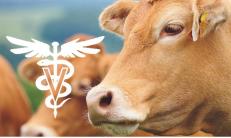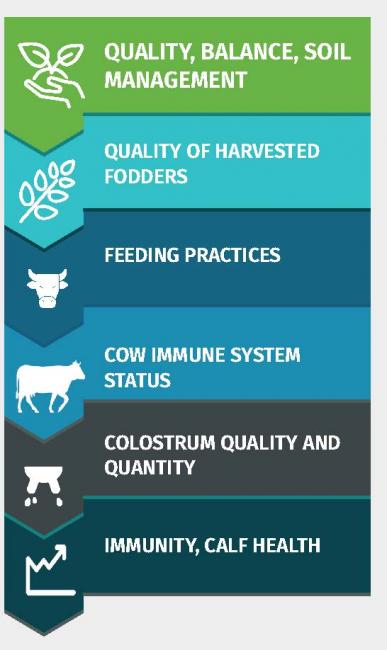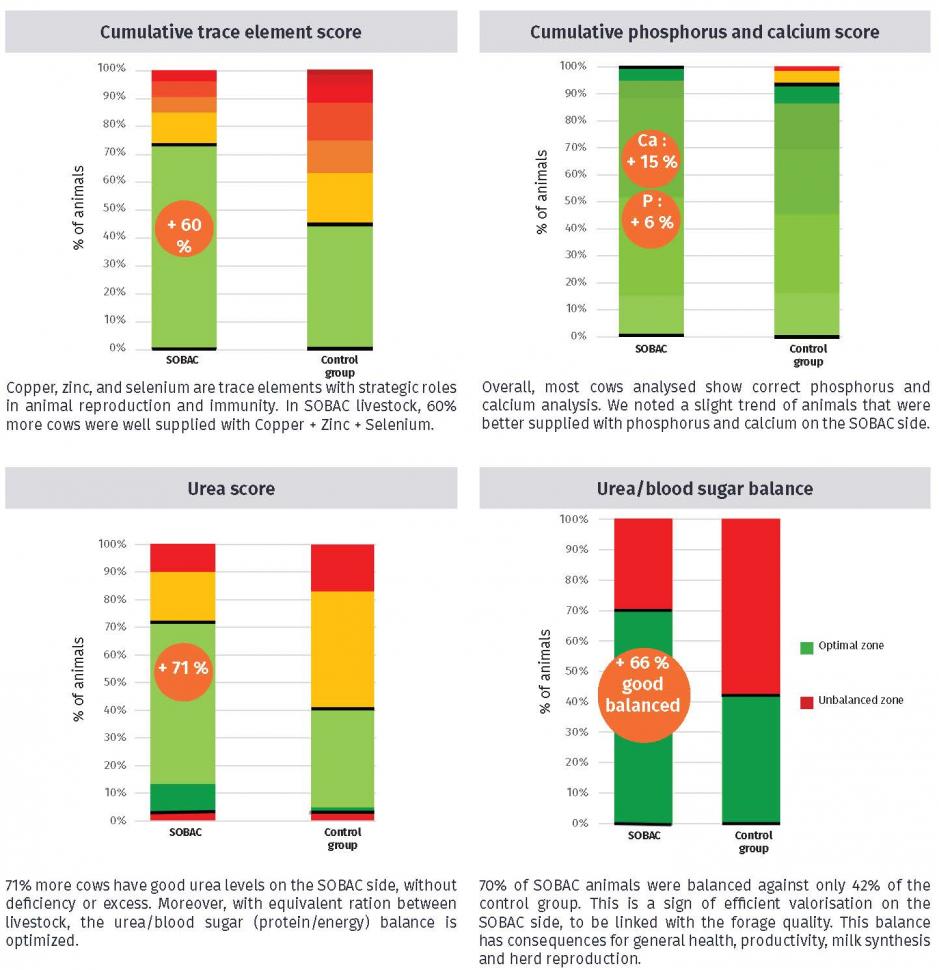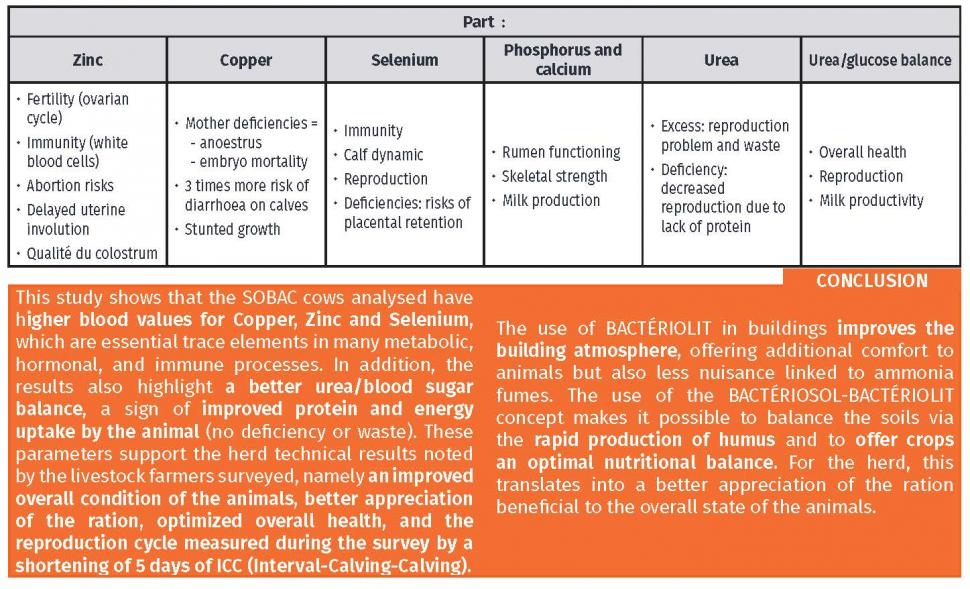
Fabien Lagoutte, veterinary
71% more cows have good urea levels on the SOBAC side, without deficiency or excess.
Product/Usage
- Bactériolit
- Bactériosol concentré
Testimonial
-
Purpose of the study :
Many livestock farmers noticed the overall improvement in the health of their herd since the use of the BACTÉRIOSOL-BACTÉRIOLIT concept, especially in terms of diarrhoea in young animals and improved herd performance (growth-reproduction ...). But then, what is the impact of the concept ?
-
Study context :
Study on the Ségala mothered calves system in Aveyron (12), whose calving takes place all year round continuously:
- 20 similar livestock studied: 10 in SOBAC system and 10 in traditional system
- by farm, analysis of 5 calves (from 1 to 12 days) and 5 cows at different physiological stages (representative herd) - participation of 9 veterinary practices - 100 cows and 71 calves were analysed - results per animal analysed by Doctor Fabien Lagoutte, from the veterinary practice of Rieupeyroux (12) - study followed by Aurélie Boubal, a baccalaureate intern in Beef Production at the Lycée Agricole de Bernussou (12). Blood tests have revealed the presence or absence of deficiencies in elements and trace elements, thus giving an overall view of the health of the mothers.




RESULTS :
- 60% more cows were well supplied with Copper + Zinc + Selenium (on the SOBAC side)
- Correct phosphorus and calcium analysis with SOBAC's solutions
- Better supplied with phosphorus and calcium on the SOBAC side
- 71% more cows have good urea levels on the SOBAC side, without deficiency or excess
- The urea/blood sugar (protein/energy) balance is optimized
- 70% of SOBAC animals were balanced against only 42% of the control group
- A better general health, productivity, milk synthesis and herd reproduction with SOBAC'solutions use
THE EYE OF FABIEN LAGOUTTE, VETERINARIAN IN RIEUPEYROUX, ON THE HEALTH STUDY IN SUCKLER CATTLE FARMING :
Fabien Lagoutte, veterinary in Rieupeyroux (12), participated in the implementation of the health study initiated by SOBAC to assess the impact of Marcel Mézy’s Technologies on animal health. He shares his impressions.
FABIEN LAGOUTTE AND SOBAC
" I have known SOBAC through clients who are users. I visited SOBAC’s website to see what it was all about. I believe, as a veterinarian, that I need to know a little bit about what people do at home so that I can advise them according to their sensitivity. I wanted to know what they were looking for in the SOBAC process and how they were using it. I contacted SOBAC directly for a presentation of what they were doing. The company is based in Aveyron. I thought it was a shame that we did not know each other better.
THE IMPLEMENTATION OF THE STUDY
Jérôme Delort, SOBAC regional manager, contacted me to see if I could oversee intern Aurélie Boubal in a health study, to provide veterinary technical advice on what she was implementing. The discussions focused on: What are the parameters that can be analysed to assess the impact of the SOBAC process on health? I explained that there were many avenues from entering into the «SOBAC» process to producing «healthy calves». At the same time, we studied the same issues with our customers : how to assess the state of health of calves and their mothers according to their diet. Besides the environmental factors of the litter, it is essentially the assimilation of the mother’s food that prevails. I have always been interested in cattle diet. I explained what, in my opinion, could be done to assess this through laboratory analysis. The idea was to monitor ten SOBAC and ten non-SOBAC livestock in the study, each with five cows and their calf. All the selected livestock farms have good herd management. From my point of view, the health of the calf is necessarily linked to that of the mother but there are biases which we ignored, in particular the management of the livestock farmer around the calving. What was agreed was to select a sample of cows immediately and include the calves when they become between two and six days of age, as they are born. This made it possible to assess both the colostrum transfer to the calves and the health status of the cows.
Results
BETTER FOOD APPRECIATION ON THE SOBAC SIDE.
The main difference we saw was in the blood tests of the cows. It was more favourable with a better-balanced diet, a better appreciation on the SOBAC side. On the mineralization, on the nitrogen balance, on the energy level, we had results that were significantly better on SOBAC livestock farms. It would have been necessary to study several hundred mothers on each side to be able to statistically determine if this trend can be confirmed. We had better energy balance with better appreciation by the animals. We are likely to have a better-quality colostrum and therefore calves that will have better growth. I advised Aurélie, trainee in charge of the study, to score the animals on each parameter measured. For example, on calcium we could have satisfactory, almost satisfactory, unsatisfactory and extremely unsatisfactory score. The better the score on calcium, the more it meant that there was no deficiency. For trace elements, we used the same principle. On the SOBAC batches, there were overall very few deficiencies. These were the clearest scores because we had really observed a fairly homogeneous distribution of animals.
ALL THE CHANCES OF BETTER RESULTS ARE ON SOBAC LIVESTOCK.
Perhaps what struck me the most were the trace element results which, overall, were rather good compared to what we usually see. Both on the SOBAC and control group side, they were livestock farmers with a certain technicality, farms where we feel there is monitoring. It differs a lot from our practice because we work more often on problem livestock farms. The quality of the fodder is one of the avenues that we did not explore much. As a veterinarian I can say that, given the results of the study’s blood tests, animals are likely to fare better on SOBAC livestock farms. It is an impression; I think we are with livestock farmers who have a little more control over their diet. Overall, we are on energy states which are better and on mineral states which have a slight tendency to be better.
IT IS QUITE DIFFICULT TO CONSIDER THE ANIMALS HEALTH WITHOUT UNDERSTANDING THEIR FOOD BALANCE.
« On the whole, livestock farms are well managed. In general, SOBAC livestock farmers do not have the same vision, especially on crops. It is on this point that we see differences. Concerning the livestock farmers of my clientele using SOBAC products, these are often people who have been confronted with health concerns. They have been around a while and they are finding it hard to get by without managing the diet.
TO HAVE GOOD FODDER, YOU MUST HAVE CULTIVATION MANAGEMENT METHODS ADAPTED TO THE SOIL.
The factor of variation on the calf’s immune system depends on the mother’s immune system status and her nutritional status. She will need good fodder to produce good colostrum. The immunity of the calf, unlike in humans, is only governed by the colostrum of its mother.
The problem stems from the fact that the quality of colostrum depends on the cow’s immune system and nutritional state, which is dependent on the livestock farmer’s feeding practices. If cows do not get quality food, they will not be able to produce good colostrum. So, we come to the last element. To have good fodder, you must have cultivation management methods adapted to your soil. This is where the SOBAC process is intended to take place. It is the livestock farmer who overall, in his operation, has control over all the levers.
These are often livestock farmers who were forced to learn. For veterinarians, our goal is to support our livestock farmers. It is difficult for us to know if the solutions we propose are correctly applied.
However, we are quickly criticized for the failure of such and such measure proposed which were not always applied as advised. This can be quite badly stomached by both the veterinarian and the livestock farmer when preventive solutions fail. I am very interested in the diet of cattle and it is rare that we do not have at least a partial nutritional explanation for disorders which are recurrent. Food and health are often very compartmentalized at the farm. Health is the role of the veterinary, diet is the role of the nutritionist and the technician. It is quite complicated to consider the health of animals without having information on the balanced of their diet. And conversely. These barriers do not fall on their own, but we knock them so that they fall. There are still livestock farmers with whom it is very complicated to talk about diet. “
THE SELECTED MARKERS.
We analysed markers of energy appreciation, markers of nitrogen appreciation and the evaluation of the circulating mineral stock. Calcium and phosphorus made up the mineral part.
The energy part was evaluated by the glucose, ketone bodies and gamma GT. On the protein part, we measured the urea which is like the exhaust gas. As there is no smoke without fire, there is no urea without protein intake. If we have a problem with the fuel, we will have urea levels that will go up very high. It is a marker for both lack and big excess at the intake. The other two markers of protein intake are albumin and total protein. This allows to measure the hydration status of the animals. It also allows to assess severe and chronic deficiency states. If the urea stays very low for a very long time, the albumin and total proteins are going to be very low because of undernourishment. On the mineral side, we took calcium and phosphorus which are the two essential minerals, likely to influence the production of milk and the colostrum in particular. Then we looked at the three major trace elements: copper, zinc, and selenium.
This also makes it possible to probe the technicality of the livestock farms. For the mineral part, calcium and phosphorus, the trend is better on the SOBAC side but with a little more variability from one herd to another. It is especially the cumulative calcium/phosphorus score that is better. This study had the virtue of setting the foundation, clearing the ground, and knowing where we can go. From now on, it would be necessary to consider the other elements, in particular the fodder with its contents in trace elements, in minerals and its nitrogenous content. If we were to retain only one thing from the blood tests, it would be the urea. To retain two, it would be the urea and the glucose. For the urea, SOBAC farms are in a much better state. In these livestock farms there are few deficiencies and there are no excesses. Monoculture is reassuring in the livestock farmer’s routine for their livestock, but it is not at all good for the animals. SOBAC livestock farmers are very often already on rotation, on multi-species, so they are already in a virtuous circle.
CONCLUSION :
This study made it possible, with a limited number of samples, to highlight trends regarding better overall food appreciation in livestock farms using the SOBAC processes. The samples size is insufficient to statistically support the results. This study allows us to identify avenues of work for the future. Among the most significant elements of this study, I retain the fact that by taking control of their feeding practices, livestock farmers (SOBAC or not) allow their animals to better appreciate the ration, and thus ensuring better immune system transfer to calves. It is then a virtuous circle for the livestock farmer, because this appreciation translates into time saving, economic profitability, and a feeling of better mastering his practices."»

